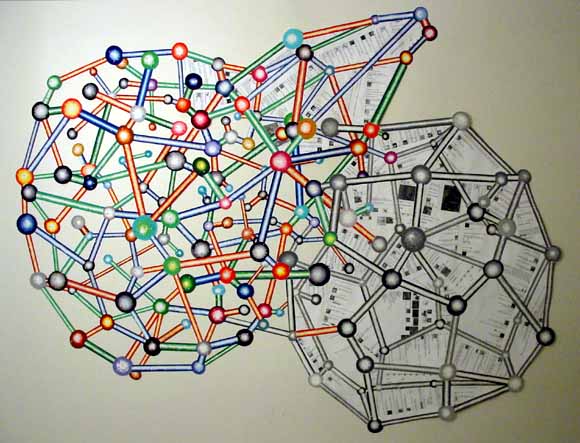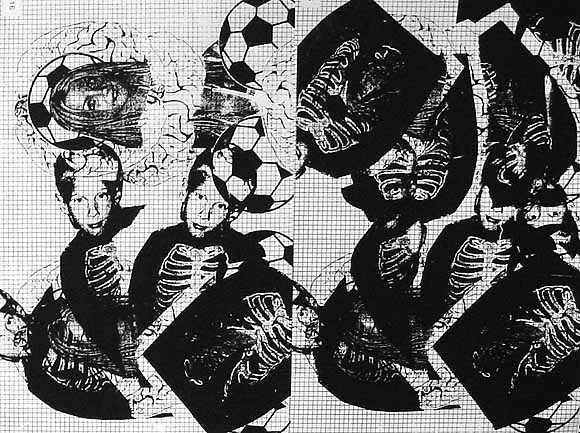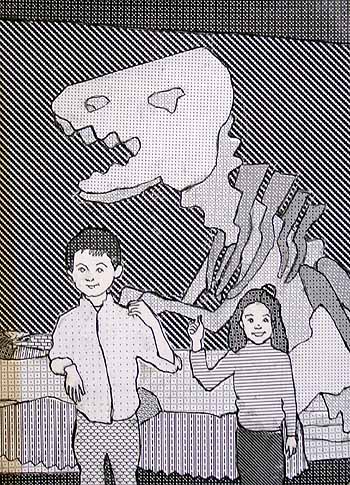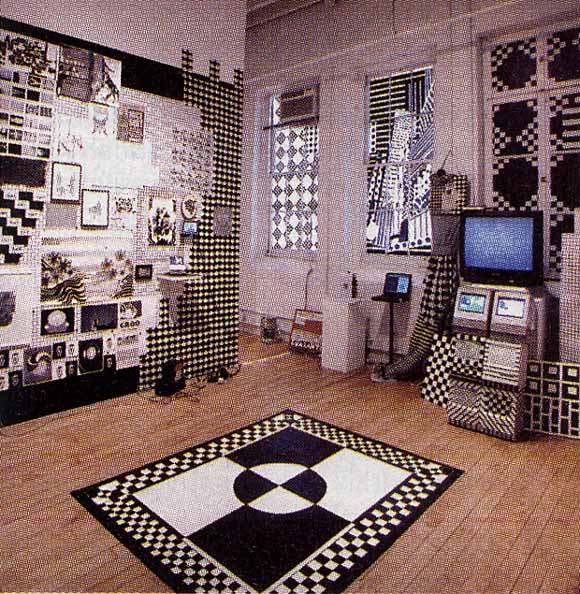View current page
...more recent posts

Dan at Iconoduel recently summarized a book by James Elkins titled "What Happened to Art Criticism?" While it is mostly fair in assessing the sources and limitations of criticism, Elkins gives short shrift to artists as originators of art world concepts, vocabularies, and judgments; in fact he gives them no shrift. He compares scholars who dispassionately critique critiques (in the field known as "reception history") to entomologists observing ant battles, with no stake at all in the outcome. And that's pretty much how he deals with artists--as people to write about but rarely read. So to Elkins' laundry list of critical sources (cultural history, philosophy, academic treatises, poetic criticism, etc.) I propose adding another: artist polemics.
Reviews, manifestos, transcribed panel discussions, artist's statements, press releases, interviews, studio talk, letters, emails, blog entries, slides, jpegs, Quicktime movies, chat room dialogue by artists: those are the engines that drive theory and judgment in the art world (electronic media being new components, obviously). Art writers who aren't also artists do participate, internalize concepts, write them up in a more dignified or cohesive or exciting way, maybe even put a new, brilliant spin on them, but their efforts will always be secondary to the main enterprise of artist-generated discourse, which necessarily includes criticism.
I think it was philosopher and former printmaker Arthur Danto who said artists don't make good critics because they're too focused, tunnel-vision-like, on their own practice (Elkins doesn't even give them that). Spoken like a true ex-artist! Donald Judd, Robert Smithson, Barnett Newman, Adrian Piper, Robert Motherwell, Art & Language, Joseph Kosuth, Barbara Kruger, Peter Halley (I could keep going) may not be the best writers or talkers in the world, but indisputably they catalyze, they content-provide, they know their history, and they judge. Clement Greenberg learned about flatness, color, push and pull and the rest of it from hanging out with artists, notably Hans Hoffman in the early days. Elkins writes as if Clem invented all his terminology himself.
Elkins devotes much ink to a weird distinction between Michael Fried and Jerry Saltz on the subject of whether critics should "take a position" when criticizing. Back in the day, the actual dialogue between Fried and an artist, Robert Smithson, on an actual position, Minimalism, was far more interesting. The only artist I can recall Elkins quoting at length is Andrea Fraser, and she is amazingly articulate. Possibly Elkins has a bone to pick with uppity artists, complaining early on that one changed what he wrote about her in a catalog essay. Deleting his word ("sad") without telling him was indisputably bad manners, but Elkins should have been more humble about his role as a catalog scribe, which is to help nail down the artist's vision as a kind of first draft of art history.

Ryan Compton, Mathematics of Composition (Brains and Grid), silkscreen, 2004, 17.5 X 22.5 inches, from "The Infinite Fill Show." "Compton invests what Leo Steinberg called the 'flatbed picture plane' of Rauschenberg and Warhol with the almost perceptible audial tint of a feeding-back electric guitar dropped from a considerable height." --October magazine (just kidding, I made that up). I believe that's Britney Spears posed like the Virgin Mary over the soccer ball and the brains.
Simon Reynolds on Beats as Fonts
The analogy that struck me was fonts. If your classic rock drum sound is something like Baskerville or Times New Roman, then the drums in the Belgian stuff or early Eurohouse or The KLF is perhaps equivalent to Arial or Lucida Console or something of that ilk: streamlined, almost-naturalistic, with a hint of futurity and this-is-the-modern-world. But like your classic rock drum sound, the beat/font doesnít really draw attention to itself, itís functional--rhythm as division of time. Pure information. Of course rock drum sound hasnít always been like that--think of psychedeliaís effects-laden beats: the billowing, phased drum-rolls on The Small Facesí "Itchycoo Park" being equivalent perhaps to the trippy typography on all those Fillmore Ballroom posters for bands like Sopwith Camel and Jefferson Airplane, woogly and pendulous to the point of illegibility.
Looksmart's FindArticles is putting old art magazine articles online; from the blowing my own horn department, I offer the following links:
Frances Colpitt's Art in America piece on abstract painting in Texas, which discusses an interesting scene we had going there in '94-'95 (continuing to this day even though several painters moved to NY). Also discussed besides yours truly are John Pomara, Aaron Parazette, David Szafranski, Jeff Elrod, Giovanni Garcia-Fenech, and others. It's amusing to read her description of Elrod's (then) slacker paintings of Atari game imagery, since he eventually became a somewhat stylish reifier of vector flotsam. (Boy, there's an article; I wonder who will write it?)
My Artforum review of the French (Corsican) artist Ange Leccia's solo at the Contemporary Arts Museum (CAM) in Houston. I described this big-scale Fluxo-conceptualist's entire show based on how it compared to various strains of abstract painting, using commodity art as a straw man. The show was good, but in retrospect I'd say it was a meditative climb-down from the work that got him known--the curious conceit of doing ephemeral Yoko Ono gestures with massive heavy-industry-produced technology.
From my first year of New York Artforum reviews, a piece on Barbara Gallucci: a 1996 show that Roberta Refused to Touch. Well, I remember she did a big roundup of hot new Soho galleries that month and managed not to mention Lauren Wittels' space, which was definitely hot at the time. There was some personal back story associated with the exhibit that I was definitely aware of, but I chose to review it with a "cold" interpretation.
 |
|
UPDATE: A large-ish image (750 x 1000) of Joe McKay's piece has been added and linked to in the post where it's discussed.
Don Wollheim Was Right: Philip K. Dick's: The Unteleported Man (AKA Lies, Inc.)
Philip K. Dick originally wrote The Unteleported Man (his title) as a 40,000 word novella for magazine publication, around '63-'64. It's a fairly tightly written, straightforward science fiction story about an Earth colony world that turns out to be a bleak garrison state rather than the pleasant place to immigrate advertised on TV (Dick claims he wrote it to go with a piece of cover art the publisher had acquired). It's not his best work, but has a good paranoid premise and features his classic "little guy" character with entrepreneurial dreams, who is dead broke and harassed by "creditor balloons." The morals are (a) governments should always monitor corporate activities (they might disguise a coup d'etat) and (b) the "good German" still exists after Nazism (which needed to be said forty years ago, one supposes). Ace Books asked Dick to expand the story, so in 1965 he wrote about seven chapters of hallucinogenic, parallel worlds nonsense ranging from brilliant to self-indulgent. Ace editor Donald Wollheim rightly rejected this material: unlike other Dick novels that contain dreamlike passages (Three Stigmata of Palmer Eldritch, Martian Time Slip), these chapters couldn't be artfully integrated into the existing nuts and bolts story, logically or dream-logically.1 The rejection nevertheless angered Dick, and after Ace went out of business, he planned to combine the original novel with the extra chapters. He hadn't completed the necessary rewrites before his death, however. Since then, publishers have released three flawed versions of the book, in a combination, I would say, of misplaced Dick-worship and the desire to cash in on every nugget of his work since he has become "hot property" in Hollywood.
There are essentially four published versions of this novel:
(1) The original 40,000 word novella, released by Ace Books as a "double" in 1966 and 1972. The title is The Unteleported Man ("TUM").
(2) A posthumous 1983 edition published by Berkley, with the "expansion chapters" originally rejected by Ace. Also titled TUM. The Berkley editor somewhat arbitrarily stuck this material (with three manuscript pages missing) at the end of the original novella, even though Dick had been working on a revised chapter order at the time of his death.
(3) A 1984 British edition titled Lies, Inc. ("LI"). This was Dick's uncompleted 1979 rework (not used by the Berkley editor for the 1983 edition), still with missing pages (only two now because he had shortened the expansion material). Science fiction writer John Sladek was hired to write connective material to fill the gaps.
(4) The 2004 edition of LI, including the expansion material and Dick's 1979 rewrites, but with the original missing pages restored after they turned up in the papers of the estate in 1985.
Most of this is explained in ex-executor Paul Williams' afterward to the 2004 edition. Aaron Barlow's online thesis chapter exhaustively outlines the differences between the 1983 TUM and the 1984 LI. Both Williams and Barlow are ardent fans and never seem to question whether it was proper to release or even consider the "expanded" novella as a finished work. While it's true the missing pages have been restored, they were unavailable to Dick when he did his 1979 revamp. Moreover, he never ultimately approved "Lies, Inc." before he died. In '79 he decided to insert the expansion material about 2/3 of the way through (completely destroying the flow of the original novella), wrote a new first chapter (not as good), and did some chopping and rewriting, but he never finished the project. Ultimately what the publishers are calling LI is a flawed or failed bit of posthumous writing: the reading public would be better served to have the original novella re-released and the expansion material and rewrites included in appendices, like DVD extras.
1. In the 1983 TUM, Rachmael is shot with an "LSD-tipped dart" after he goes through the teleporter to the garrison world to rescue Freya, and the resulting hallucinatory description is excellent, but the rest of the expansion material is meandering and meaningless, plot-wise (although there is much thoughtful and clever writing). In both editions of LI, Rachmael goes through the teleporter several chapters earlier, at a point when he is supposedly in a starship on his way to Fomalhaut. The feeble parallel world foreshadowing in the added first chapter just isn't enough explanation to justify this glaring non-sequitur. Only the most loyal fan will try to defend the hallucinatory chapters as somehow proceeding from--or subverting--the core novel.
 To the left is Time Out NY's "Infinite Fill Show" review; on the whole it's better than the NY Times'. Below is the accompanying photo. My notes on the review: To the left is Time Out NY's "Infinite Fill Show" review; on the whole it's better than the NY Times'. Below is the accompanying photo. My notes on the review:At least this writer got Jamie Arcangel's sex right, but it's Foxy Production, singular. "[F]ew of the artworks reveal the influence of the computer age..." This is to calm regular readers of the Time Out art page, who might be freaked out by too much computer art in a gallery. "Several of the artists display Op Art grids made from media as disparate as a latch hook and cassette tapes, including a vinyl piece by the curators' mother." That is how that sentence should read: I suspect editorial garbling in the published text. Props to Joe McKay for undulations catching the critic's eye. His piece is good, a sort of moving Suprematist abstraction gliding in and out of a permanent dark band on a broken PowerBook. Broken consumer tech=very good. [J]ust as computers generate complexity using a binary system of 1s and 0s, the Arcangels' two simple criteria [black & white + repeating patterns] have yielded a superabundance of pattern--not to mention artwork..." Yes! Bemoaners of the "crisis of criticism," you get your theory where you find it in the art world; this is a variant of Sally McKay's here on this blog (scroll down to comments). Roberta Smith only got the second half of this thought. |
 |
